Metallic Character
The ability of an atom to donate electrons and form positive ion (cation) is known as electropositivity or metallic character. Down the group, metallic character increases due to increase in atomic size and across the period, from left to right electropositivity decreases due to decrease in atomic size.
Non-Metallic Character
The ability of an atom to accept electrons to form a negative ion (anion) is called non-metallic character or electronegativity. The elements having high electro-negativity have a higher tendency to gain electrons and form anion. Down the group, electronegativity decreases due to increase in atomic size and across the period, from left to right electronegativity increases due to decrease in atomic size
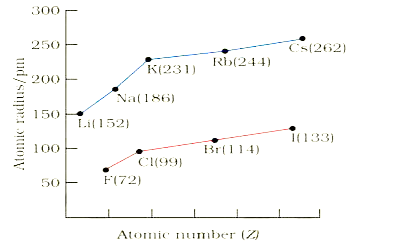
Which of the following has highest electronegativity?
F
Cl
Br
I
The correct Answer is:A
Step by step video, text & image solution for Metallic Character The ability of an atom to donate electrons and form positive ion (cation) is known as electropositivity or metallic character. Down the group, metallic character increases due to increase in atomic size and across the period, from left to right electropositivity decreases due to decrease in atomic size. Non-Metallic Character The ability of an atom to accept electrons to form a negative ion (anion) is called non-metallic character or electronegativity. The elements having high electro-negativity have a higher tendency to gain electrons and form anion. Down the group, electronegativity decreases due to increase in atomic size and across the period, from left to right electronegativity increases due to decrease in atomic size Which of the following has highest electronegativity? by Chemistry experts to help you in doubts & scoring excellent marks in Class 10 exams.
Updated on:21/07/2023Topper's Solved these Questions
- NEW CHAPTERS AND QUESTIONS BASED ON LATEST TYPOLOGIES INTRODUCED BY CBSE FOR 2021-22 EXAMINATION BOOK - OSWAL PUBLICATIONCHAPTER - NEW CHAPTERS AND QUESTIONS BASED ON LATEST TYPOLOGIES INTRODUCED BY CBSE FOR 2021-22 EXAMINATION EXERCISE - CARBON AND ITS COMPOUNDS (VISUAL CASE - BASED QUESTIONS)
15 Videos
- METALS AND NON-METALSBOOK - OSWAL PUBLICATIONCHAPTER - METALS AND NON-METALSEXERCISE - Board corner(Long answer type questions)
20 Videos
- NTSE 2019 - 20 BOOK - OSWAL PUBLICATIONCHAPTER - NTSE 2019 - 20 EXERCISE - (CHEMISTRY) ATOMS AND MOLECULES (STAGE - 2)
1 Videos
Similar Questions
Read the following and answer the question
Metallic Character:
The ability of an atom to donate electrons and form positive ion (cation) is known as electro-positivity or metallic character. Down the group, metallic character increases due to increase in atomic size and across the period, from left to right electro-positivity decreases due to decrease in atomic size
Non-Metallic Character:
The ability of an atom to accept electrons to form a negative ion (anion) is called non-metallic character or electronegativity. The elements having high electro-negativity have a higher tendency to gain electrons and form anion.
Down the group, electronegativity decreases due to increase in atomic size and across the period, from left to right electro-negativity increases due to decrease in atomic size.
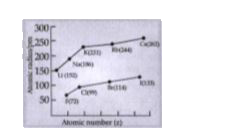
Which of the following correctly represents the decreasing order of metallic character of Alkali metals plotted in the graph ?
View SolutionElectropositivity is the non-metallic character of an element.
View Solution
Knowledge Check
Metallic Character
The ability of an atom to donate electrons and form positive ion (cation) is known as electropositivity or metallic character. Down the group, metallic character increases due to increase in atomic size and across the period, from left to right electropositivity decreases due to decrease in atomic size.
Non-Metallic Character
The ability of an atom to accept electrons to form a negative ion (anion) is called non-metallic character or electronegativity. The elements having high electro-negativity have a higher tendency to gain electrons and form anion. Down the group, electronegativity decreases due to increase in atomic size and across the period, from left to right electronegativity increases due to decrease in atomic size
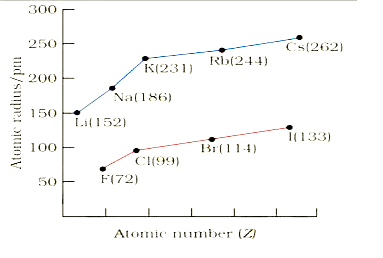
Which of the following correctly represents the decreasing order of metallic character of Alkali metals plotted in the graph?ACs>Rb>Li>Na>KBK>Rb>Li>Na>CsCCs>Rb>K>Na>LiDCs>K>Rb>Na>LiMetallic Character
The ability of an atom to donate electrons and form positive ion (cation) is known as electropositivity or metallic character. Down the group, metallic character increases due to increase in atomic size and across the period, from left to right electropositivity decreases due to decrease in atomic size.
Non-Metallic Character
The ability of an atom to accept electrons to form a negative ion (anion) is called non-metallic character or electronegativity. The elements having high electro-negativity have a higher tendency to gain electrons and form anion. Down the group, electronegativity decreases due to increase in atomic size and across the period, from left to right electronegativity increases due to decrease in atomic size
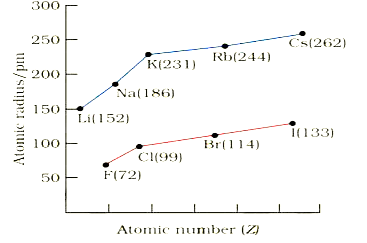
Which of the following reason correctly justifies that “Fluorine (72pm) has smaller atomic radius than Lithium (152pm)”?AF and Li are in the same group. Atomic size increases down the groupBF and Li are in the same period. Atomic size increases across the period due to increase in number of shellsCF and Li are in the same group. Atomic size decreases down the groupDF and Li are in the same period and across the period atomic size/radius decreases from left to right.Metallic Character
The ability of an atom to donate electrons and form positive ion (cation) is known as electropositivity or metallic character. Down the group, metallic character increases due to increase in atomic size and across the period, from left to right electropositivity decreases due to decrease in atomic size.
Non-Metallic Character
The ability of an atom to accept electrons to form a negative ion (anion) is called non-metallic character or electronegativity. The elements having high electro-negativity have a higher tendency to gain electrons and form anion.Down the group, electronegativity decreases due to increase in atomic size andacross the period, from left to right electronegativity increases due to decreasein atomic size
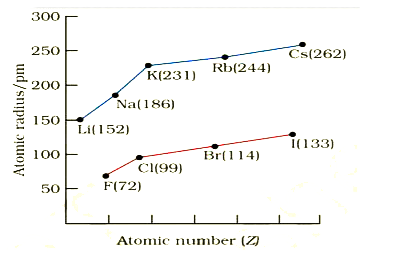
Identify the reason for the gradual change in electronegativity in halogensdown the group.AElectronegativity increases down the group due to decrease in atomic sizeBElectronegativity decreases down the group due to decrease in tendency to lose electronsCElectronegativity decreases down the group due to increase in atomic radius/ tendency to gain electron decreasesDElectronegativity increases down the group due to increase in forces of attractions between nucleus & valence electrons
Metallic Character
The ability of an atom to donate electrons and form positive ion (cation) is known as electropositivity or metallic character. Down the group, metallic character increases due to increase in atomic size and across the period, from left to right electropositivity decreases due to decrease in atomic size.
Non-Metallic Character
The ability of an atom to accept electrons to form a negative ion (anion) is called non-metallic character or electronegativity. The elements having high electro-negativity have a higher tendency to gain electrons and form anion.Down the group, electronegativity decreases due to increase in atomic size and across the period, from left to right electronegativity increases due to decrease in atomic size
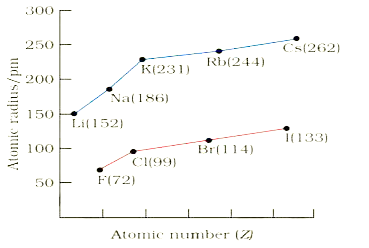
Hydrogen is placed along with Alkali metals in the modern periodic table though it shows non-metallic character
View SolutionElectropositive or metallic character
View SolutionFrom Be to Ba electropositive or metallic character
View SolutionIncrease in atomic size down the group is due to
View SolutionIncrease in atomic size down the group is due to
View Solution
